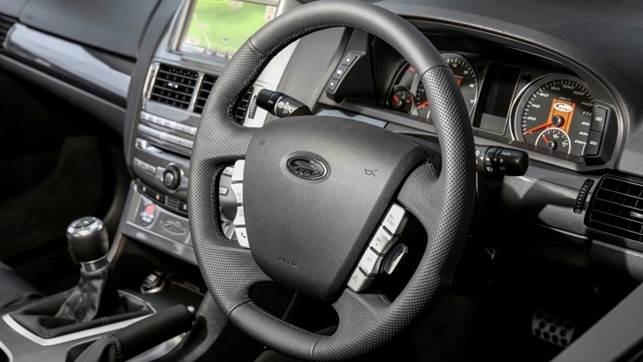And there’s plenty of that now too. The
engine’s delivery is more polished, it’s smoother as it builds to its peak but
it still needs revs to really get moving, coming good around 3,000rpm, on the
rampage at 4,000rpm and going ape crazy at 5,000rpm. There’s plenty of charger
whine in the cabin, but the exhaust note is too subdued. It sounds fine from
the pavement however.
The ZF six-speed auto used to be the
benchmark back in the latter stages of the 2000s, but self shifters have moved
on. What we once viewed as prime auto programming now has us reaching for the
manual selector to try and stir things along, and even then those changes
aren’t that snappy. It has us wondering if those buyers that opted for the Tremec
TR 6060 equipped manual might have made the better choice in terms of both
collectability and driver enjoyment.

Falcon
driving position is just plain weird, while the build quality is average too
The V8 likes to party, drinking in the high
teens but that’s better than the truly ravenous HSV GTS. And speaking of the
enemy...the GT-F isn’t as fast as the most powerful Aussie car ever. The HSV
clocked off the 0-100km/h sprint in 4.2sec, while the GT-F managed no better
than 4.8sec. Course, the 6.2-litre LSA spews torque from right down low,
whereas the GT-F’s double overhead cam eight needs a few thousand revs to
really hike, and by then the GTS has already pulled a gap. The GT-F drives off
the line cleaner than any previous iteration thanks to a better traction
control system (courtesy of the new ECU) but still the TC light flickers all
the way through the timed run on our usual chipseal surface. Once the 5.0-litre
has hit its straps though, there’s not much between ’em, the GT-F clicking off
the 80-120km/h run in 2.45sec, the GTS running it in 2.29sec.

There
is frustrating super-high seating position
We noted the GTS to be a few clicks quicker
through some of our wider, more open reference corners too. The GT-F’s front
end starts to push eventually, while the GTS equipped with rear torque
vectoring is able to hang on longer. The GT-F has better steering though; it’s
more feel some and direct, and the car’s more nimble in the tighter corners.
The upgraded ESP helps smooth out the
delivery of the torque. You’ll hear a dut-dut-dutter as the spark is retarded
to stem the flow but it keeps a fairly tight rein on the rear end. The ESP
doesn’t allow much in the way of sideways play like the HSV product does
however.

The
rear wing and door handles are painted black
The GT-F has all that Ford Falcon DNA like
the weird driving position, average build quality, so-so rear accommodation and
the lumpy boot floor. But none of that matters as 48 NZ-bound GT-Fs have all
been snapped up by the blue oval faithful at $99,351. This car, number 1, will
be sold by Ford NZ via dealer auction, while build number 50 will be auctioned
for charity, with proceeds going to Variety. So there are still two chances to
own a GT-F if you’re willing to pay a premium. The GT-F doesn’t set any new
standards in the realm of the super sedan, outgunned by newer machinery, but
it’s still a character, a decent drive and a fitting end to the GT line. Vale
Falcon GT, thanks for the memories.